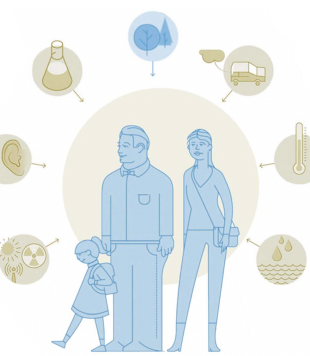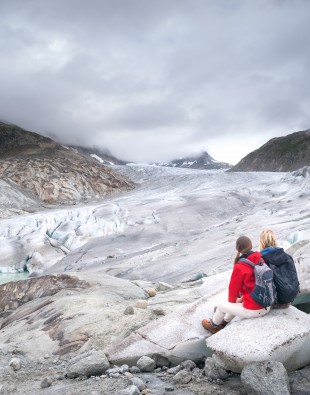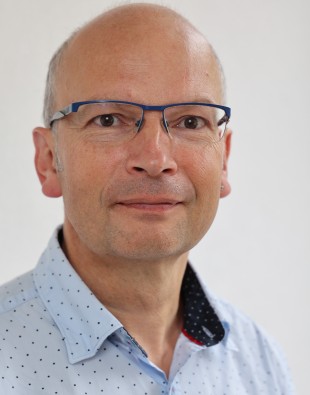
“A lot of environmental risks aren’t even on the radar”
Sep. 2022Environment and health
Even though traffic volumes have risen, air quality in Switzerland has improved significantly. However, environmental research shows there are still gaping holes. Going forward, we should focus more attention on an environment that encourages us to be active, says environmental epidemiologist Martin Röösli.
Professor Röösli, is the envi- ronment we are living in today healthier than 30 years ago?
It’s hard to give a generalised answer to that because some environmental factors – particulate pollution, for example – have improved significantly in Switzerland, whereas others, such as summer heatwaves, have got worse in the wake of global warming. Although negative and alarmist messages tend to hold sway in many people's minds, as well as in the media, I’m inclined to think that environmental conditions in the country have improved overall. For example, there are far fewer indoor wood-burning stoves, which has resulted in a substantial reduction in air pollution – the greatest environmental risk to human health in quantitative terms.
«Im Umweltbereich erreicht man am meisten, wenn man weniger auf das individuelle Verhalten abzielt, sondern Verhältnisprävention betreibt und die Rahmenbedingungen verändert.»
How, exactly?
Scientists use what are known as health impact assessments to calculate the disease burden caused by particular risk factors. The latest such assessment from the 2019 Global Burden of Disease Study concludes that annually, air pollution causes 6.5 million premature deaths worldwide, an estimated 3,500 of which are in Switzerland. In other words, particulate pollution claims significantly more lives than heat, for example, which causes up to 1,000 additional deaths in a hot summer.
Those are striking figures.
Even though the relative health risks that environmental pollutants present for individuals are fairly small, they are very significant in public health terms because they affect a large number of people. That puts me in a permanent quandary to a certain extent. It’s difficult to find a good way to talk about the risks without scaring people, since that has negative implications for health too. All the same, I think it’s important that we as a society don’t treat the risks lightly. After all, the health-related effects of air pollution kill several thousand people in Switzerland each year. Nevertheless, air pollution in Switzerland has declined since the 1990s. This is quite amazing when you consider that both the population and the traffic volumes have risen dramatically during the same period.
Last year, the World Health Organization (WHO) adjusted its guideline values for air pollutants downwards. Why was that?
An increasing amount of environmental research appears to show that for many pollutants there are no harmless concentrations below particular thresholds, but that health risks increase even at low exposure levels. Twenty years ago, when I first started out in epidemiology, there were very few studies of the health impact of airborne pollutants. The studies were too small in scope to produce meaningful information on the risks of low exposure. Nowadays there are a lot more and larger studies, so it is possible to model exposure in the population with much greater accuracy and detail. That means there are now relatively good, reliable figures to show that even low exposure levels have an effect.
Eigentlich könnte man sich auch vorstellen, dass eine geringe Belastung gesundheits- fördernd wirkt, weil sie die körpereigenen Abwehr- und Reparaturmechanismen aktiviert und trainiert.
Bei den Luftschadstoffen, aber auch bei den ionisierenden Strahlen lassen die Daten keinen solchen Schluss zu, diese Risikofaktoren sind immer schädlich. Allerdings sieht es bei der UV-Strahlung etwas anders aus, wir brauchen davon eine gewisse Menge, damit unsere Haut Vitamin D produzieren kann. Auch beim Schall gibt es angenehme Geräusche, und in einem schalltoten Raum ist es den meisten Menschen nicht wohl.
Aber abgesehen davon glaube ich persönlich, dass der gesellschaftliche Anspruch auf absolute Risikofreiheit kontraproduktiv ist. Viele Umweltschadstoffe entstehen als Nebeneffekt einer erwünschten Tätigkeit: Wir schätzen die Vorteile der erhöhten Mobilität und sind froh, im Winter unsere Wohnungen heizen zu können. Ich bin überzeugt, dass sich technisch noch einiges machen lässt, um die damit einhergehenden Schadstoffemissionen zu verringern. Und meiner Meinung nach sollten wir das auch tun. Aber wahrscheinlich lassen sich die Emissionen nicht ganz vermeiden.
«Viele Umweltschadstoffe entstehen als Nebeneffekt einer erwünschten Tätigkeit: Wir schätzen die Vorteile der erhöhten Mobilität und sind froh, im Winter unsere Wohnungen heizen zu können.»
Das tönt nicht besonders optimistisch.
Ich sehe noch erhebliches Verbesserungspotenzial. Doch wir sollten inskünftig nicht nur technische Lösungen suchen. Mindestens so wichtig wie weitere Optimierungen am Auspuff von Autos sind integrative Ansätze, in denen es auch um Raumplanung und die Förderung des Langsamverkehrs geht. Wer regelmässig zu Fuss oder auf dem Velo unterwegs ist, lebt gesünder und im Schnitt auch zehn Jahre länger als körperlich inaktive Personen. Dabei geht es weniger um sportliche Höchstleistungen, die man erbringen muss, als vielmehr um ein tägliches Mass an Bewegung, das sich stark auf die Lebenserwartung auswirkt.
Deshalb hat eine Umwelt, die uns animiert, aktiv zu sein, einen grossen Einfluss auf die Gesundheit: Regelmässige Bewegung und Aktivitäten im Fuss- und Veloverkehr verhindern in der Schweiz jedes Jahr rund 12000 Herz-Kreislauf-Erkrankungen und 4000 Fälle von Depression. Gleichzeitig tragen diese Fortbewegungsarten als Ersatz für motorisierten Verkehr zu einer besseren Luftqualität bei.
So far, we’ve been talking mainly about airborne pollutants. What’s the situation as regards soil and water pollution?
Around 20,000 different chemical substances are manufactured in Switzerland. While many of them are used in industry, they are also used in agriculture and households. We know very little about how much these chemicals affect the Swiss population. This is a gaping hole in environmental research. We are aware that medicine or pesticide residues can be detected in groundwater or drinking water, but their effects on our health are only well documented in cases of acute poisoning. In contrast, studies of low-dose, longterm pollution are hampered by significant uncertainties.
«Die Luftschadstoffe sind die eigentliche Paradedisziplin in der Umweltforschung, damit hat man vor 40 Jahren angefangen – und heute weiss man sehr viel. Aber der Themenbereich Umwelt und Gesundheit ist mannigfaltig und umfasst viel mehr als die Luftqualität.»
Where else are there gaps in our knowledge?
Air pollution is the showcase discipline in environmental research, because work started on it 40 years ago and we now know a lot about it. But environment and health constitute a wide-ranging complex of issues that comprises much more than just air quality. A lot of other environmental risks aren’t even on the radar. For example, nitrate levels in drinking water exceed thresholds levels in many places in Switzerland. There is a plausible mechanism by which nitrate ingestion can lead to colon cancer, yet there has been virtually no research into this issue. In addition, very little is happening on this at a political level; nitrate pollution of drinking water is simply being accepted.

Im Gegensatz zur Luftqualität sind viele Umwelteinflüsse auf die Gesundheit noch zu wenig erforscht, beispielsweise der Nitratgehalt im Trinkwasser.
Wer in Waldnähe wohnt, atmet bessere Luft und ist auch weniger Lärm ausgesetzt, als wer in der Nähe einer viel befahrenen Strasse wohnt.
Das stimmt für die meisten Schadstoffe. Aber es können sich nicht alle leisten, in der Nähe von Grünflächen zu wohnen. Wer weniger Geld zur Verfügung hat, muss sich mit anderen Wohnsituationen begnügen, das ist eine riesige Ungerechtigkeit. In den allermeisten Studien, egal zu welchem Thema im Bereich Umwelt und Gesundheit, wird der sozioökonomische Status statistisch herausgerechnet, um eine Verzerrung der Resultate zu vermeiden. Aber ich bin überzeugt, dass die Umwelt- und Arbeitsbedingungen zu einem grossen Teil erklären, wieso Personen mit einem tiefen sozioökonomischen Status eine geringere Lebenserwartung haben als Personen mit einem hohen Einkommen.
In general, what would you like to see going forward?
Greater cooperation between spatial planning, environmental and public health specialists. And the development of holistic approaches to prevention so that we see more quiet,
low-pollutant neighbourhoods with short, attractive connections. Encouraging people to be active not only helps reduce health costs, it also improves quality of life. People who are active are more content in their life.
Prof. Dr. Martin Röösli
After graduating in environmental science from ETH Zurich, Martin Röösli did his PhD on airborne pollutants and the associated health risks at Basel’s air hygiene office and at the Institute of Social and Preventive Medicine (ISPM) at the University of Basel, where he is now Professor of environmental epidemiology. At the SwissTropical and Public Health Institute (SwissTPH), Martin Röösli is Head of the Environmental Exposures and Health unit.




